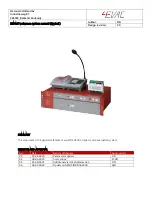
Non-invasive blood pressure
pressures, the amplitude (which changes based on the pressure within the cuff) and
the frequency of these pulsations (which is dependent on the patient’s heart rate),
oscillometric devices can non-invasively determine blood pressure.
●
x = Time(s)
●
y = Pressures
1.
Systolic (50%)
2.
Mean (100%)
3.
Diastolic (75%)
4.
Extracted pulse wave
5.
Cuff pressure
NIBP measurement technologies
The DINAMAP Classic technology measures the mean arterial pressure, then
determines the systolic and diastolic values. The technology examines pulses from the
cuff and waits for two sequential pulses equal in both frequency and amplitude. It will
not deflate the cuff until it has good data. Artifact and false pulses are rejected.
The first determination initially pumps up to a target cuff pressure of 160 mmHg for
adult, 140 mmHg for child or 110 mmHg for infant. The initial target pressure preset
can be adjusted to a lower (or higher) initial target pressure.
PDM and TRAM use the DINAMAP Step Deflation technology. During the deflation
process, the monitor measures two consecutive pulsations in cuff pressure. If their
amplitude differs by an acceptably small amount and the time interval between the
pulsations matches the previous time intervals, the pulsations are averaged and
stored along with the corresponding cuff pressure. The cuff is then deflated to the
next step (in steps of 5-10 mmHg). As the deflation occurs, oscillation waves are
assessed for strength and amplitude until the maximum oscillation amplitude or
MAP is obtained.
If either of the above criteria is not met, the cuff pressure is maintained until two
consecutive pulsations are detected that meet the criteria. Eventually, if the cuff is
maintained at one pressure step for longer than one minute or the determination time
exceeds two minutes, the monitor will time out and display an error.
2062971-001
CARESCAPE Modular Monitors
229
Summary of Contents for CARESCAPE
Page 38: ...38 CARESCAPE Modular Monitors 2062971 001 ...
Page 114: ...Setting up the monitor before use 114 CARESCAPE Modular Monitors 2062971 001 ...
Page 146: ...Alarms 146 CARESCAPE Modular Monitors 2062971 001 ...
Page 218: ...Pulse oximetry 218 CARESCAPE Modular Monitors 2062971 001 ...
Page 234: ...Non invasive blood pressure 234 CARESCAPE Modular Monitors 2062971 001 ...
Page 260: ...Temperature 260 CARESCAPE Modular Monitors 2062971 001 ...
Page 274: ...Cardiac output 274 CARESCAPE Modular Monitors 2062971 001 ...
Page 280: ...Mixed venous oxygen saturation SvO 280 CARESCAPE Modular Monitors 2062971 001 ...
Page 338: ...Patient Spirometry 338 CARESCAPE Modular Monitors 2062971 001 ...
Page 372: ...Neuromuscular transmission 372 CARESCAPE Modular Monitors 2062971 001 ...
Page 404: ...Laboratory data 404 CARESCAPE Modular Monitors 2062971 001 ...
Page 410: ...Calculations 410 CARESCAPE Modular Monitors 2062971 001 ...
Page 416: ...Drug calculations 416 CARESCAPE Modular Monitors 2062971 001 ...
Page 424: ...Trends 424 CARESCAPE Modular Monitors 2062971 001 ...
Page 432: ...Snapshots and events 432 CARESCAPE Modular Monitors 2062971 001 ...
Page 462: ...Cleaning and care 462 CARESCAPE Modular Monitors 2062971 001 ...
Page 528: ...Abbreviations yr year yrs years 528 CARESCAPE Modular Monitors 2062971 001 ...
Page 546: ...Skills checklist 546 CARESCAPE Modular Monitors 2062971 001 ...
Page 547: ...content ...
















































